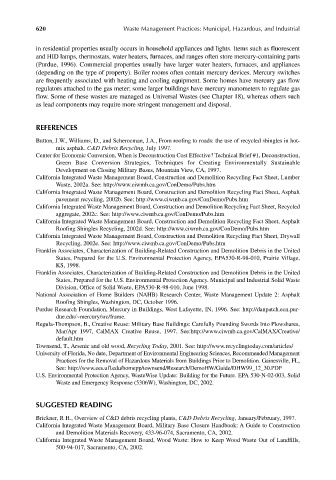Page 649 - Materials Chemistry, Second Edition
P. 649
CAT3525_C21.qxd 1/27/2005 12:56 PM Page 620
620 Waste Management Practices: Municipal, Hazardous, and Industrial
in residential properties usually occurs in household appliances and lights. Items such as fluorescent
and HID lamps, thermostats, water heaters, furnaces, and ranges often store mercury-containing parts
(Purdue, 1996). Commercial properties usually have larger water heaters, furnaces, and appliances
(depending on the type of property). Boiler rooms often contain mercury devices. Mercury switches
are frequently associated with heating and cooling equipment. Some homes have mercury gas flow
regulators attached to the gas meter; some larger buildings have mercury manometers to regulate gas
flow. Some of these wastes are managed as Universal Wastes (see Chapter 18), whereas others such
as lead components may require more stringent management and disposal.
REFERENCES
Button, J.W., Williams, D., and Scherocman, J.A., From roofing to roads: the use of recycled shingles in hot-
mix asphalt. C&D Debris Recycling, July 1997.
Center for Economic Conversion, When is Deconstruction Cost Effective? Technical Brief #1, Deconstruction,
Green Base Conversion Strategies, Techniques for Creating Environmentally Sustainable
Development on Closing Military Bases, Mountain View, CA, 1997.
California Integrated Waste Management Board, Construction and Demolition Recycling Fact Sheet, Lumber
Waste, 2002a. See: http://www.ciwmb.ca.gov/ConDemo/Pubs.htm
California Integrated Waste Management Board, Construction and Demolition Recycling Fact Sheet, Asphalt
pavement recycling, 2002b. See: http://www.ciwmb.ca.gov/ConDemo/Pubs.htm
California Integrated Waste Management Board, Construction and Demolition Recycling Fact Sheet, Recycled
aggregate, 2002c. See: http://www.ciwmb.ca.gov/ConDemo/Pubs.htm
California Integrated Waste Management Board, Construction and Demolition Recycling Fact Sheet, Asphalt
Roofing Shingles Recycling, 2002d. See: http://www.ciwmb.ca.gov/ConDemo/Pubs.htm
California Integrated Waste Management Board, Construction and Demolition Recycling Fact Sheet, Drywall
Recycling, 2002e. See: http://www.ciwmb.ca.gov/ConDemo/Pubs.htm
Franklin Associates, Characterization of Building-Related Construction and Demolition Debris in the United
States, Prepared for the U.S. Environmental Protection Agency, EPA530-R-98-010, Prairie Village,
KS, 1998.
Franklin Associates, Characterization of Building-Related Construction and Demolition Debris in the United
States, Prepared for the U.S. Environmental Protection Agency. Municipal and Industrial Solid Waste
Division, Office of Solid Waste, EPA530-R-98-010, June 1998.
National Association of Home Builders (NAHB) Research Center, Waste Management Update 2: Asphalt
Roofing Shingles, Washington, DC, October 1996.
Purdue Research Foundation, Mercury in Buildings, West Lafayette, IN, 1996. See: http://danpatch.ecn.pur-
due.edu/~mercury/src/frame.
Regula-Thompson, B., Creative Reuse: Military Base Buildings: Carefully Pounding Swords Into Plowshares,
Mar/Apr 1997, CalMAX Creative Reuse, 1997. See:http://www.ciwmb.ca.gov/CalMAX/Creative/
default.htm
Townsend, T., Arsenic and old wood, Recycling Today, 2001. See: http://www.recyclingtoday.com/articles/
University of Florida, No date, Department of Environmental Engineering Sciences, Recommended Management
Practices for the Removal of Hazardous Materials from Buildings Prior to Demolition. Gainesville, FL,
See: http://www.ees.ufl.edu/homepp/townsend/Research/DemoHW/Guide/DHW99_12_30.PDF
U.S. Environmental Protection Agency, WasteWise Update: Building for the Future. EPA 530-N-02-003, Solid
Waste and Emergency Response (5306W), Washington, DC, 2002.
SUGGESTED READING
Brickner, R H., Overview of C&D debris recycling plants, C&D Debris Recycling, January/February, 1997.
California Integrated Waste Management Board, Military Base Closure Handbook: A Guide to Construction
and Demolition Materials Recovery, 433-96-074, Sacramento, CA, 2002.
California Integrated Waste Management Board, Wood Waste: How to Keep Wood Waste Out of Landfills,
500-94-017, Sacramento, CA, 2002.

